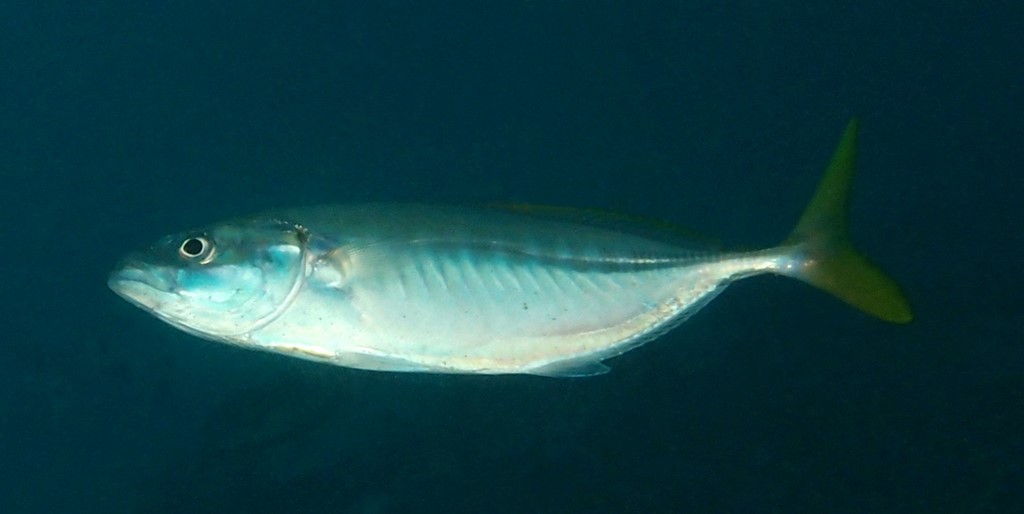ATULE MATE - (CUVIER, 1833)
Actinopterygii (Gigaclass) > Actinopteri (Class) > Teleostei (Subclass) > Carangiformes (Order) > Carangoidei (Suborder) > Carangidae (Family) > Caranginae (Subfamily) > Atule (Genus)
Selar queue jaune, Carangue maté, Yellowtail scad, Finlet scad, Barred yellowtail scad, Yellow-tail scad, Northern yellowtail scad, Geelstert-skad, Xaréu cauda amarela, Jurel rabo amarillo, Mabuta-shima-aji, Mate-aji, نيزكة أصفر الذّيل, 四破鲹仔, 黄尾瓜仔,
Synonymes
Alepes mate (Cuvier, 1833)
Atule mute (Cuvier, 1833)
Carangus politus (Jenkins, 1903)
Caranx affinis (Rüppell, 1836)
Caranx hasseltii (Bleeker, 1851)
Caranx mate (Cuvier, 1833)
Caranx xanthurus (Cuvier, 1833)
Decapterus fasciatus (Bleeker, 1872)
Decapterus lundini (Jordan & Seale, 1906)
Decapterus normani (Bertin & Dollfus, 1948)
Decapterus politus (Jenkins, 1903)
Selar affinis (Rüppell, 1836)
Selar broekmeyeri (Bleeker, 1855)
Selar hasseltii (Bleeker, 1851)
Selar mate (Cuvier, 1833)
------------------------
Description
Dorsal spines (total): 9; Dorsal soft rays (total): 22-25; Anal spines: 3; Anal soft rays: 18-21; Gill rakers: 10-13 + 26-31; Vertebrae: 10 + 14. Both jaws with single series of small, conspicuous teeth; Upper jaw (in large adults) with 2-3 rows of small canines anteriorly; Adipose eyelid well developed and completely covering eye except for a vertical slit centred on pupil; Shoulder girdle (cleithrum) margin smooth, without papillae; Terminal dorsal and anal rays finlet-like in adults, about twice length of adjacent rays and a little more separated but joined by interradial membrane; Lateral line gently arched anteriorly, with junction of curved and straight parts below vertical from sixth to eighth soft rays of second dorsal fin; Scales in curved part of lateral line: 39-57; Straight part with 0-10 scales and 36-49 scutes. Max. length: 30.0 cm TL. Depth range: 1 - 80 m.
Selar queue jaune, Carangue maté, Yellowtail scad, Finlet scad, Barred yellowtail scad, Yellow-tail scad, Northern yellowtail scad, Geelstert-skad, Xaréu cauda amarela, Jurel rabo amarillo, Mabuta-shima-aji, Mate-aji, نيزكة أصفر الذّيل, 四破鲹仔, 黄尾瓜仔,
Synonymes
Alepes mate (Cuvier, 1833)
Atule mute (Cuvier, 1833)
Carangus politus (Jenkins, 1903)
Caranx affinis (Rüppell, 1836)
Caranx hasseltii (Bleeker, 1851)
Caranx mate (Cuvier, 1833)
Caranx xanthurus (Cuvier, 1833)
Decapterus fasciatus (Bleeker, 1872)
Decapterus lundini (Jordan & Seale, 1906)
Decapterus normani (Bertin & Dollfus, 1948)
Decapterus politus (Jenkins, 1903)
Selar affinis (Rüppell, 1836)
Selar broekmeyeri (Bleeker, 1855)
Selar hasseltii (Bleeker, 1851)
Selar mate (Cuvier, 1833)
------------------------
Description
Dorsal spines (total): 9; Dorsal soft rays (total): 22-25; Anal spines: 3; Anal soft rays: 18-21; Gill rakers: 10-13 + 26-31; Vertebrae: 10 + 14. Both jaws with single series of small, conspicuous teeth; Upper jaw (in large adults) with 2-3 rows of small canines anteriorly; Adipose eyelid well developed and completely covering eye except for a vertical slit centred on pupil; Shoulder girdle (cleithrum) margin smooth, without papillae; Terminal dorsal and anal rays finlet-like in adults, about twice length of adjacent rays and a little more separated but joined by interradial membrane; Lateral line gently arched anteriorly, with junction of curved and straight parts below vertical from sixth to eighth soft rays of second dorsal fin; Scales in curved part of lateral line: 39-57; Straight part with 0-10 scales and 36-49 scutes. Max. length: 30.0 cm TL. Depth range: 1 - 80 m.
Color
Body olive green dorsally, shading to white or silvery ventrally; Prominent black spot posteriorly on opercle at level of upper eye; Often with 10 dark bars on side of body; Dorsal and caudal fins dusky greenish yellow.
Etymology
Atule: from local name for this and related fishes in Polynesia (called Akule in Hawaï).
mate: from mate-paré, local name for this species at Puducherry, India, co-type locality
Original description: Caranx mate Cuvier, 1833 - Type localities: Puducherry, India; Seychelles; New Guinea; Antjer Strait.
Distribution
Biology
Adults inhabit mangroves and coastal bays in pelagic waters. They form schools in inshore waters, or singly. Are mainly diurnal. They feed mainly on crustaceans and planktonic invertebrates such as copepods, including cephalopods. They swim fast in midwater in pursuit of zooplankton.
Last update: 1, March 2023
Body olive green dorsally, shading to white or silvery ventrally; Prominent black spot posteriorly on opercle at level of upper eye; Often with 10 dark bars on side of body; Dorsal and caudal fins dusky greenish yellow.
Etymology
Atule: from local name for this and related fishes in Polynesia (called Akule in Hawaï).
mate: from mate-paré, local name for this species at Puducherry, India, co-type locality
Original description: Caranx mate Cuvier, 1833 - Type localities: Puducherry, India; Seychelles; New Guinea; Antjer Strait.
Distribution
Red Sea; Indo-West Pacific: East Africa, Persian Gulf, Madagascar and western Mascarenes (La Réunion) east to Hawaiian Islands (U.S.A.) and French Polynesia, north to southern Japan, south to Western Australia, New South Wales (Australia) and New Caledonia.
Biology
Adults inhabit mangroves and coastal bays in pelagic waters. They form schools in inshore waters, or singly. Are mainly diurnal. They feed mainly on crustaceans and planktonic invertebrates such as copepods, including cephalopods. They swim fast in midwater in pursuit of zooplankton.
Last update: 1, March 2023
